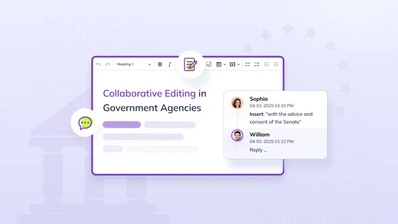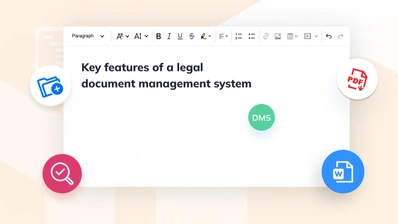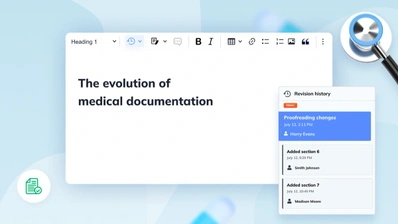Mastering document management: Best practices for organizing your files

Good documentation is the key to running your business. But it’s useless if you can’t find anything when you need it. That’s where document management comes in – keeping important files organized and easily accessible. The Information Age may have started last century, but some organizations are still managing their documents like it’s 1959. By implementing document management best practices, you save time, stress and money – and here’s how to do it.
Ever felt like you spend as much time hunting for the right document as you do working on it? You’re not alone. On average, Americans spend a quarter of their work week just searching for documents – some spend as much as five hours a day looking for them. Worse still, when key information is scattered across different apps, files and pages, even the simplest of tasks become frustrating.
The good news is that proper document management processes have never been easier to put in place. With the help of the latest workflow tools, you can streamline cluttered file systems into something much more, well, manageable.
But let’s not get ahead of ourselves. As those sobering survey statistics show, many businesses clearly aren’t aware how disorganized their current systems are. Some companies think document management isn’t something they need to worry about at all. As a report by Xerox put it:
For far too long, document management has been seen as one of those areas that only the biggest companies need to worry about and get right. But documents are the lifeblood of any business – no matter the size.
So, let’s start with the basics and go from there. And remember, if your work involves documents, then you should be using document management best practices.
What is document management?
Document management is the practice of storing, organizing, retrieving, and sharing any documents relevant to your business. No matter whether your documents are on a shared server, in a folder on your desktop, or inside a filing cabinet, you’re doing document management. A document management system (DMS) is a purpose-built software solution for filing and finding documents.
The filing cabinet itself is considered the first example of modern document management. It’s not clear exactly who invented vertical hanging files and the filing cabinets used to house them. Some credit American Edwin Grenville Seibels, who applied for a patent for a vertical filing system back in 1898, but his patent was rejected as it was purely an idea, not a unique device.
Regardless of who invented them, vertical filing cabinets soon became the standard way to store and sort documents efficiently.
With the advent of photocopying in the 1960s, business documents became even more abundant. Once everyone could get their own copy of a document, filing cabinets became a crucial piece of furniture in any office. All that changed in the 1980s, when early PCs, word processors and servers showed that documents could be created and stored digitally.
Scanners meant those mountains of existing paper documents could be digitized, too.
Document management processes go digital
As workplaces switched to using PCs, the shift from filing cabinets to today’s digital document management systems was on. The advantages of going digital were obvious: documents would last longer, be accessible from anywhere, and take up much less space.
By the early 90s, more user-friendly interfaces were putting DMS tools in the hands of the average office worker. Corporate intranets played host to HTML-based document management solutions made with software like Microsoft Sharepoint.
With business document management becoming less dependent on records managers or secretaries, finding the info you needed should have been easier. Instead, in many workplaces, clear central file organization gradually gave way to digital clutter and confusion. Where people could previously consult their own filing cabinet or request a document from a central point, now they had to find what they wanted in an ever-growing sprawl of digital files.
Unfortunately, this still seems to be the situation for many businesses today. 80% of people have been forced to recreate an existing document because they couldn’t find it on their corporate network. To avoid problems like this, there’s one key question that needs to be answered.
What does a proper document management process look like?
A proper document management process uses all the benefits of digitization, starting with a user-friendly DMS. More than just a digital filing cabinet, a well organized DMS handles key information better by:
-
Making document text, tags and categories searchable, so you don’t have to remember which folder the document was filed in.
-
Making documents easily updatable, so important info is kept current.
-
Providing a centralized hub for documents that’s accessible from wherever you are.
-
Ensuring the files themselves and changes to them are trackable, to aid with compliance.
-
Storing files in a durable, widely compatible format, to make sure data is secured and doesn’t get lost.
A modern DMS may provide most of these features by default, but like all software, it’s only useful when it’s used properly. Your DMS is the backbone of your document management processes, but the structures you put in place around that are the muscles keeping it all upright. With that in mind, let’s look at some key document management best practices.
5 essential document management best practices
Different industries have different document management requirements, depending on compliance frameworks, client needs and so on. It’s important to be aware of your company’s requirements when setting up your document management processes. These five essentials are a great starting point.
1. Set clear expectations from day one
As with any other business process, document management needs buy-in and understanding from the people in your workplace. There’s no point setting up a cutting-edge DMS if no one knows how they’re supposed to use it. So make it clear what your DMS is meant to capture. Is it for document creation, or just for filing? Do you use it to share documents with clients, or is it internal use only?
Most importantly, set up an organizational structure for your files and make sure everyone knows how to follow it. If necessary, put someone in charge of keeping the DMS clean and orderly on an ongoing basis – it’s a much easier task to handle, if it’s been set up before the DMS is full of randomly filed documents.
2. Move on from print
No matter what industry you’re in, an over-reliance on printed documents is becoming an increasingly costly mistake. But a proper digital document management process isn’t just about untangling disorganization. It’s also an essential requirement for any business with hybrid or remote staff.
In 2020, 97% of organizations with minimal or no digital document processes found the switch to remote work significantly reduced their productivity. With no easy access to paper-based documents from home, people simply couldn’t get their work done.
Remember though, once you digitize your document management, don’t just replicate your old, print-based processes. It needs to go further than that, for example, if approvals are a major part of your workflow, make sure your DMS supports digital signatures to avoid the print-sign-scan loop.
3. Remember, you don’t have to keep everything
Once you’ve moved on from storing printed documents, it’s tempting to save everything – after all, it doesn’t take up office space. It’s an urge you should resist. Despite the way many businesses behave, effective document management is as much about what you choose to leave out as it is about keeping every document your office produces.
The more documents you store in your DMS, the greater the chances of duplication, and the harder it is to find the most important (and/or current) information. Beyond the documents you need for administration and compliance, it’s worth thinking twice before adding another one to the pile.
4. Automate the most common processes
Automation is one way to combat document sprawl in your DMS. Some platforms allow you to automatically sort and store files based on tags, department of origin, or other metadata. This ensures consistency and makes documents easier to find.
Repetitive document creation tasks can also be automated. Use predefined document templates to produce an order form or an invoice for a client directly in your DMS, saving time and money.
5. Ensure proper version control
A major advantage of a DMS is the ability to keep track of previous versions of a document. In some DMS platforms, you can see who accessed a file, when, and any changes they made to it. This is necessary for data privacy and security, especially in industries with strict regulations such as finance or healthcare.
Plus, version control and revision history aren’t just a must for regulatory compliance. They’re also great for hybrid work or asynchronous collaboration – people can make changes and leave feedback on a document without erasing a colleague’s work, which allows everyone to contribute their feedback.
Implementing document management in your organization
To set up proper document management in your business, you need to first make sure your DMS can support the architectural structures you need to put in place. Your DMS should also have all the features necessary for your document management processes.
While things like search and security are largely standard in modern DMS platforms, other crucial features aren’t so easy to find. Even today, many document management apps are more focused on serving as an archive of PDFs than a comprehensive solution.
WYSIWYG difference in a DMS
To get the most out of your document management workflow, make sure your DMS can integrate a modern rich text editor.
Documents must be updatable, so your DMS needs a familiar editing interface, so people can easily add new information. Those edits need to be trackable, too, meaning features like version control and revision history are essential. And with multiple people viewing and editing the documents, cloud-based collaboration features are the best way to make sure your content is accessible to everyone. The ability to import and store documents in a flexible, searchable format – and export them to PDF or Word files when needed – keeps your documents durable and future-proof.
The linchpin for all these features is the rich text editor in your DMS.
Without a word processor-style WYSIWYG interface for easily creating and updating documents, a DMS will always end up as a static digital archive. Automations like templated documents and exporting to PDF also depend on a robust, customizable editor.
CKEditor is a leading-edge collaborative rich text editor that supports full text search straight out of the box. All paid subscription plans come with key plugins like Templates, Document Outline, Table of Contents, while others include collaboration features such as Revision History and Track Changes for version control, plus Import from Word and Export to PDF and Word and more.
To learn more about leveling up your DMS, contact us today.


